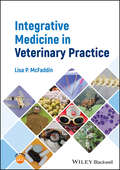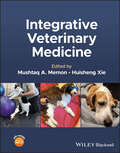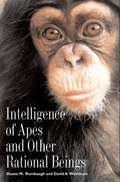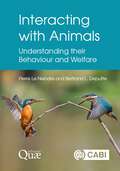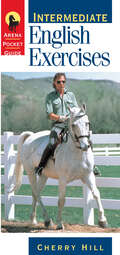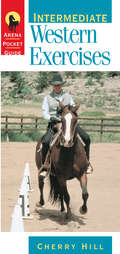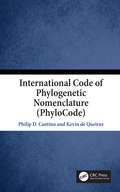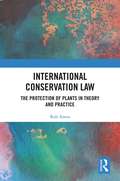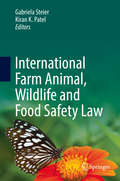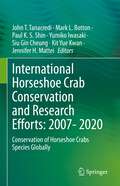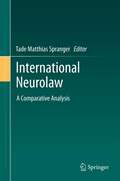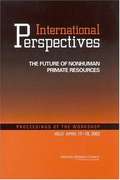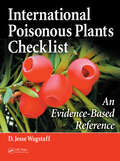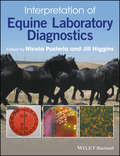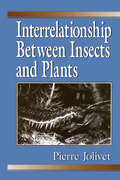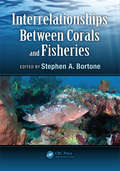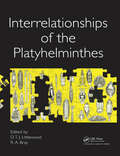- Table View
- List View
Integrative Medicine in Veterinary Practice
by Lisa P. McFaddinIntegrative Medicine in Veterinary Practice Enables the entire veterinary team to seamlessly incorporate integrative medicine into everyday practice Integrative Medicine in Veterinary Practice is a unique resource designed to introduce the basic concepts of ten different integrative modalities to all members of the hospital team to establish a baseline of knowledge: explaining how patients will benefit from their use, discussing return on investment, informing veterinarians of available courses and suggested reading materials, walking managers through staff training, and providing client education materials. Supplemental web-based documents and presentations increase the ease with which staff are trained and clients are educated. Integrative medicine is not an all-or-nothing concept. This umbrella term encompasses a wide spectrum of treatment modalities. Therapies can be used individually or in combination, as part of a multimodal approach, and applied easily to every patient or used in select cases. Sample topics covered in Integrative Medicine in Veterinary Practice include: Photobiomodulation, covering light, laser specifics, mechanisms of action, supplies and equipment, and techniques Veterinary Spinal Manipulation Therapy (VSMT), covering pain in veterinary patients, mechanisms of action, adjustment vs. manipulation vs. mobilization, techniques, and post-adjustment recommendations Acupuncture, covering acupuncture point selection using traditional Chinese veterinary medicine (TCVM) and Western medicine techniques, mechanisms of action, safety, and practical applications. Chinese Herbal Medicine (CHM), covering TCVM fundamentals as it applies to herbal classification and selection, herb production, safety, and formulation, and CHM applications. Integrative Medicine in Veterinary Practice is a valuable resource for all veterinary hospital team members, from customer service representatives to veterinary assistants/technicians, practice managers, and veterinarians. The text is also helpful to veterinary students interested in integrative medicine, or those taking introductory integrative medicine courses.
Integrative Veterinary Medicine
by Huisheng Xie Mushtaq A. MemonIntegrative Veterinary Medicine Practical guide integrating holistic modalities into Western veterinary practice to help with patient treatment Integrative Veterinary Medicine provides a clinically oriented, evidence-based guide to integrating complementary and conventional therapies into veterinary practice. Covering acupuncture, manual therapies, botanical and herbal medicine, integrative nutrition, and physical rehabilitation, the book draws information on these modalities together into a single resource. Rooted in evidence-based medicine, it demonstrates how to use these modalities in veterinary practice. The book begins by discussing the basic concepts of integrative veterinary medicine, then examines each modality in detail. A companion website offers video clips showing acupuncture techniques. In Integrative Veterinary Medicine, readers can expect to find detailed information on topics such as: Anatomy and physiology of acupuncture with relation to soft tissue and neurologic concepts, and traditional Chinese theory of acupuncture (Yin and Yang, Five Element Theory, and The Meridians) Veterinary manipulative therapy (neurology, biomechanics, and available evidence), and massage therapy and myofascial principles Origins and major systems of herbal therapy with selected evidence-based interventions and adverse events, herb-drug interactions, supplement evaluation, and regulation Trends in nutrition, such as raw diets, home-prepared diets, grain-free diets, owner perception, and current marketing Covering common modalities across all species in one volume, Integrative Veterinary Medicine is an essential reference for any veterinary practitioner wishing to use integrative techniques in their practices, as well as veterinary students, academics, and researchers involved in programs of study related to integrative veterinary medicine.
Integrity, 130,000 BC: The Cerutti Mastodon Site
by Bonnye MatthewsIn a super strong patriarchal society of one clan in southern California 130,000 years ago, a girl twin is born before her brother twin, and as a stroke of luck, she is not left to die, as would have been the case for a second-born girl. The girl, Elka, grows to be strong, fearless, and spiritual, things that didn't fit well in the culture into which she meets life, a culture where each man rules over his family without limits on his authority. One man, her grandfather, Geol, rules the clan. The clan's culture sees birth as perfection of person and every infraction of the clan rules as a loss of integrity, a brokenness. Lose a certain, unspecified, amount of integrity, and one is exiled from the clan forever, as there is no remedy for loss of too much integrity. s her father sinks deeper into power-driven attempts to kill the strong spirit within Elka, a spirit he fears, a possible escape plan opens up for Elka. Will the plan save her? Or, will she be victimized as one member of the clan already is, to become to the extreme of their belief, a slave to every unreasonable whim of her husband for the rest of her life? Elka opts for escape, agonizing at separation from her twin and others she loves in the clan. Will she make it? Will she survive the separation? Will she find a place where she can thrive in the huge land that surrounds her? Read to discover the answers.
Intelligence of Apes and Other Rational Beings
by Duane M. Rumbaugh David A. WashburnDuane M. Rumbaugh and David A. Washburn show that learning by apes--and even by animals usually considered to have little or no intelligence-- can illuminate our own processes of cognition. That humans and other animals have much in common is only the point of departure for the authors' portrayal of the richness of learning, perception, and communication skills across the animal kingdom. Relying on their own research as well as that of colleagues and others in the field, they provide a comprehensive overview of both theoretical and empirical advances with regard to cognition, perception, emotion, and behavior in both humans and animals.
Interacting with Animals: Understanding their Behaviour and Welfare
by Dr Pierre Le Neindre Dr Bertrand DeputteAnimal behaviour and, as a result, animal welfare are increasingly complex areas of study, with the diversity of the animal kingdom and new research findings ensuring there is no one, easy answer. Instead, we need to take a holistic approach, combining scientific principles with both philosophical and ethical considerations to develop all-inclusive policies and legislation that decide how society should interact with domestic, farm and native animals. With a focus on domestic animals, while also referring to wild species to reinforce the arguments, this book: · promotes direct observation for those who claim to be interested in animals, their behaviour, and their welfare. · considers the concept of consciousness, how it can be assessed, and how it relates to suffering and animal welfare more widely. · emphasizes the need to understand better how animals behave both with humans and outside of human influence, considering the diversity of behaviour and sensorial capacities across species. · includes author knowledge and expertise across a wide range of animal species, from primates to farm animals, and across animal living situations from intensive to free ranging. We are far from having all the answers, so this book also raises questions that require further research and focus, such as the way animals are likely to act based on their recent and whole-of-life experiences. Still, this review of the topic, an updated translation of the French language work Vivre parmi les animaux, mieux les comprendre, is an invaluable resource for everyone with an interest in animal behaviour and welfare.
Intermediate English Exercises (Arena Pocket Guides)
by Cherry HillWith this pocket-sized guide in hand, you'll find it easy to develop and perfect your English riding skills. Cherry Hill's exercises will help you learn to hone balance and precise use of aids, improve bending, polish transitions, develop lateral work, and begin collection.
Intermediate Western Exercises (Arena Pocket Guides)
by Cherry HillTake your riding to the next level! Hone balance, tighten transitions, and begin collection as you develop your Western riding skills. In this equestrian workbook, veteran trainer Cherry Hill presents a series of focused exercises that include clearly stated goals, illustrated directions, arena maps, and appropriate safety concerns. With a pocket-sized trim perfect for easy reference in the saddle, this book is designed to help you improve your riding form and maximize the benefits of your training sessions.
International Code of Phylogenetic Nomenclature (PhyloCode): A Phylogenetic Code of Biological Nomenclature
by Kevin de Queiroz Philip D. CantinoThe PhyloCode is a set of principles, rules, and recommendations governing phylogenetic nomenclature, a system for naming taxa by explicit reference to phylogeny. In contrast, the current botanical, zoological, and bacteriological codes define taxa by reference to taxonomic ranks (e.g., family, genus) and types. This code will govern the names of clades; species names will still be governed by traditional codes. The PhyloCode is designed so that it can be used concurrently with the rank-based codes. It is not meant to replace existing names but to provide an alternative system for governing the application of both existing and newly proposed names. Key Features Provides clear regulations for naming clades Based on expressly phylogenetic principles Complements existing codes of nomenclature Eliminates the reliance on taxonomic ranks in favor of phylogenetic relationships Related Titles: Rieppel, O. Phylogenetic Systematics: Haeckel to Hennig (ISBN 978-1-4987-5488-0) de Queiroz, K., Cantino, P. D. and Gauthier, J. A. Phylonyms: A Companion to the PhyloCode (ISBN 978-1-138-33293-5).
International Conservation Law: The Protection of Plants in Theory and Practice
by Rob AmosThrough a combination of theoretical and empirical approaches, this book explores the role of international environmental law in protecting and conserving plants. Underpinning every ecosystem on the planet, plants provide the most basic requirements: food, shelter and clear air. Yet the world’s plants are in trouble; a fifth of all plant species are at risk of extinction, with thousands more in perpetual decline. In a unique study of international environmental law, this book provides a comprehensive overview of the challenges and restrictions associated with protecting and conserving plants. Through analysing the relationship between conservation law and conservation practice, the book debates whether the two work symbiotically, or if the law poses more of a hindrance than a help. Further discussion of the law’s response to some of the major threats facing plants, notably climate change, international trade and invasive species, grounds the book in conservation literature. Using case studies on key plant biomes to highlight the strengths and weaknesses of the law in practice, the book also includes previously unpublished results of an original empirical study into the correlations between the IUCN Red List and lists of endangered/protected species in international instruments. To conclude, the book looks to the future, considering broader reforms to the law to support the work of conservation practitioners and reshape humanity’s relationships with nature. The book will be of interest to scholars and students working in the field of international environmental law and those interested more broadly in conservation and ecological governance frameworks.
International Farm Animal, Wildlife and Food Safety Law
by Gabriela Steier Kiran K. PatelThis volume is an inspiring and breakthrough piece of academic scholarship and the first of its kind featuring a comprehensive reader-friendly approach to teach the intricacies of the various aspects of international farm animal, wildlife conservation, food safety and environmental protection law. The selected focus areas are grouped in sections, such as agrobiodiversity, fishing and aquaculture, pollinators and pesticides, soil management, industrial animal production and transportation, and international food trade. Farm animal welfare, environmental protection, biodiversity conservation, and food safety are the core of the selected chapters. Every chapter provides real-world examples to make the complex field easy to understand. With its systematic approach, this book is devoted to anyone interested in the subject, becomes a valuable resource for professionals working in food regulation, and provides a solid foundation for courses and master's programs in animal law, environmental policy, food and agriculture law, and regulation of these subjects around the world. Through its emphasis on sustainable food production, this work offers a cutting-edge selection of evolving topics at the heart of the pertinent discourse. As one of its highlights, this books also provides "Tools for Change," a unique compilation and analysis of laws from the major farm animal product trading nations. With these tools, practitioners, advocates, policy makers and other state-holders are equipped with information to start work toward improving farm animal welfare, wildlife conservation, and food safety through the use of law and policy.
International Horseshoe Crab Conservation and Research Efforts: Conservation of Horseshoe Crabs Species Globally
by Mark L. Botton John T. Tanacredi Siu Gin Cheung Paul K. S. Shin Yumiko Iwasaki Kit Yue Kwan Jennifer H. MatteiThe first International Conference on Horseshoe Crab’s Conservation conducted at Dowling College, USA, (2007) and it’s proceedings published by Springer in 2009, prompted the continued research and conservation efforts presented at subsequent conferences and colloquium in Hong Kong, Taiwan, (2011); San Diego, CA, (2014), (CERF); Japan, Sasebo (2015) and an accepted inclusion for a special session on Horseshoe Crabs at the 2017 CERF Conference held in Providence, RI, USA. All these aforementioned conferences contributed manuscripts, posters, workshop “position papers”, and oral presentations the majority of which have not been published in total. In 2015, Carmichael et al. had published by Springer the majority of manuscripts from the 2011 Hong Kong / Taiwan conference. However, workshop results and all subsequent presentations and workshops were not. The Japan conference presented over 40 papers alone. A collection of all workshop summaries, poster presentations and new manuscript submittals (San Diego, CA; Sasebo, Japan; and Providence, RI) as well as products prepared for the IUCN World Congress in Hawaii, (2016), are included potential contributions for review in this compilation now available for global distribution in this Springer Nature publication.The “Proceedings of International Conferences on the Biology and Conservation of Horseshoe Crabs”, thus contains over 50 manuscripts and a diversified collection of documents, photos and memorabilia covering all four of the horseshoe crab species globally: their biology, ecology evolution, educational, and societal importance. This book exposes the impacts that humans have imposed on all four of these species, revealing through the coordinated effort of horseshoe crab scientists with the IUCN, of the worldwide need for a clear conservative effort to protect these paleo- survival organisms from a looming extinction event. Biologists, conservationists, educators, and health professionals will all welcome this book not only for exploration of its pharmacological interest, but also for the mystery of their longevity. This book also clarifies the future research needs and the conservation agenda for the species worldwide. Anyone working or studying estuaries on a global scale, will need to obtain this seminal work on horseshoe crabs.
International Neurolaw
by Tade Matthias SprangerWhereas the past few years have repeatedly been referred to as the "era of biotechnology", most recently the impression has emerged that at least the same degree of attention is being paid to the latest developments in the field of neurosciences. It has now become nearly impossible to maintain an overview of the number of research projects dealing with the functionality of the brain - for example concerning its organizational structure - or projects dealing with the topics of legal responsibility, brain-computer interface applications, neuromarketing, lie detection or mind reading. These procedures are connected to a number of legal questions concerning the framework conditions of research projects as well as the right approach to the findings generated. Given the primary importance of the topic for the latest developments, it is essential to compare the different legal systems and strategies that they offer for dealing with these legal implications. Therefore, the book International Neurolaw - A Comparative Analysis contains several country reports from around the world, as well as those of international organizations such as UNESCO, in order to show the different legal approaches to the topic and possible interactions.
International Perspectives: The Future of Nonhuman Primate Resources
by Institute for Laboratory Animal ResearchThe future of nonhuman primate (NHP) resources is a concern of scientists, veterinarians, and funding authorities. An April 2002 workshop brought participants from all over the world to discuss various aspects of the issue such as current shortfalls and excesses in NHP breeding and exportation programs, the status of breeding and conservation programs internationally, the development of specific pathogen-free colonies, difficulties in transporting NHP, and challenges in the management of NHP colonies.
International Poisonous Plants Checklist: An Evidence-Based Reference
by D. Jesse WagstaffKnowledge of plant toxicity has always been important, but the information has not always been reliable. Now, increasing international trade is drawing attention to the inadequacy of regional information and highlighting the geographical fragmentation and notorious discrepancies of thinly documented information. The international community of safet
International Velvet
by Bryan ForbesVelvet Brown made history when, against all the odds, she won the Grand National on a horse bought with a raffle ticket. But the years have flown and the Velvet of today is a very different person from that fourteen-year-old girl. Inspired by Enid Bagnold's classic story National Velvet, Bryan Forbes has written an imaginative sequel, this time set in the highly competitive world of international equestrian events--tests of courage and skill which lead, for the lucky few, to that summit of every rider's ambition, the Olympic Games. It is a story told on many levels, tracing an ambition passed down through the generations, and the conflicts that ambition produces. Velvet's attempts to relive her own past through Sarah, her young orphaned niece, bring her face to face with what she has become. In this heartwarming account of a woman seeking to find herself again, and a child struggling towards maturity, the author builds to an exciting climax which highlights the enormous pressures demanded of those who attempt to succeed in international sport. International Velvet is now a major MGM film, produced and directed by Bryan Forbes, starring Tatum O'Neal, Christopher Plummer, Anthony Hopkins and Nanette Newman.
Internet Guide to Pet Health
by Elizabeth ConnorWith the staggering amount of pet health information available on the Internet, it is often difficult to find exactly what you are looking for. The Internet Guide to Pet Health is a one-stop guide that weeds through all the clutter to bring you only the most dependable sources and relevant content. This comprehensive compilation of annotated links will serve as a handy, useful, and easy-to-consult guide for persons who appreciate animals and/or own domestic pets of all kinds, especially cats and dogs. This text also features a full glossary of medical terms, bibliography, and a quick-find index.The health needs of pet animals have become as complex and specialized as those of humans. Pet owners, veterinarians, and animal lovers alike need authoritative, reliable, and up-to-date information about caring for the health and well-being of pets. The Internet Guide to Pet Health offers a quick, easy, and comprehensive reference to quality Web sites that focus on the health and welfare of animal companions. The Internet Guide to Pet Health will help you pinpoint reliable information on: • the health benefits of pet ownership • diseases transmitted by pets • pet food safety • animal care and welfare societies and organizations • death, dying, and euthanasia • poisons, dangerous situations, and other hazards • spaying and neutering • traveling with pets • pet-specific care for dogs, cats, small animals, and fish • surgery, surgical procedures, and hospitalization • exercise and training • dental care, diet, and nutrition • disabled pets • service and therapy animals • and much, much more! The Internet Guide to Pet Health is an ideal resource for anyone who is directly involved in the lives of pet companions or simply an animal lover. Medical librarians in academic medical centers and teaching hospitals; consumer health and public librarians; veterinarians and veterinary clinic staff; public health personnel; animal trainers; and groomers will also find this to be an invaluable text.
Interpretation of Equine Laboratory Diagnostics
by Nicola Pusterla Jill HigginsInterpretation of Equine Laboratory Diagnostics offers a comprehensive approach to equine laboratory diagnostics, including hematology, clinical chemistry, serology, body fluid analysis, microbiology, clinical parasitology, endocrinology, immunology, and molecular diagnostics. Offers a practical resource for the accurate interpretation of laboratory results, with examples showing real-world applications Covers hematology, clinical chemistry, serology, body fluid analysis, microbiology, clinical parasitology, endocrinology, immunology, and molecular diagnostics Introduces the underlying principles of laboratory diagnostics Provides clinically oriented guidance on performing and interpreting laboratory tests Presents a complete reference to establish and new diagnostic procedures Offers a practical resource for the accurate interpretation of laboratory results, with examples showing real-world applications Covers hematology, clinical chemistry, serology, body fluid analysis, microbiology, clinical parasitology, endocrinology, immunology, and molecular diagnostics Introduces the underlying principles of laboratory diagnostics Provides clinically oriented guidance on performing and interpreting laboratory tests Presents a complete reference to established and new diagnostic procedures
Interrelationship Between Insects and Plants
by Pierre JolivetOne of the world's most insightful writers on the subject brings together an array of important and readable information on the ways in which insects and plants coexist in nature. Interrelationship Between Insects and Plants is a rare and expansive look at the intertwining of these two vastly different species. Its aim is to summarize in a simple a
Interrelationships Between Corals and Fisheries
by Stephen A. BortoneInterrelationships Between Corals and Fisheries is derived from a workshop held by the Gulf of Mexico Fishery Management Council in Tampa, Florida in May 2013, where world authorities came together to discuss the current problems in managing tropical fisheries and offered suggestions for future directions for both researchers and environmental reso
Interrelationships of the Platyhelminthes
by D. T. J. Littlewood R. A. BrayInterrelationships of the Platyhelminthes elucidates the role of the flatworms in the animal kingdom. It brings together results from an international group of experts, spanning many disciplines, who give evidence for the phylogeny of flatworms and constituent major taxa. A combined approach, using traditional comparative techniques along with the modern techniques of molecular phylogeny, is utilized to show that the monophyly of the phylum is not fully established, and that the phylum may in fact consist of two groups: the acoels and their relatives, which are basal metazoans, and the Rhabditophora, which is a more derived group.
Interrupting Chicken
by David Ezra SteinIt's bedtime for the little red chicken, and papa is going to read her a story. "You're not going to interrupt the story tonight, are you?" asks Papa. "Oh no, Papa. I'll be good," says the little red chicken. But she just can't help herself! Whether it's Hansel and Gretel, Little Red Riding Hood, or Chicken Little, as soon as the story gets going . . . out jumps the little red chicken--right into the story--saving the characters from danger and ending the story early. Will that chicken ever get to sleep?
Interrupting Chicken (Interrupting Chicken)
by David Ezra SteinLittle Red Chicken wants Papa to read her a bedtime story. but interrupts him almost as soon as he begins each tale.
Interspecies Ethics
by Cynthia WillettInterspecies Ethics explores animals' vast capacity for agency, justice, solidarity, humor, and communication across species.
Interspecies Ethics
by Cynthia WillettInterspecies Ethics explores animals' vast capacity for agency, justice, solidarity, humor, and communication across species.
Interspecies Ethics
by Cynthia WillettInterspecies Ethics explores animals' vast capacity for agency, justice, solidarity, humor, and communication across species.
